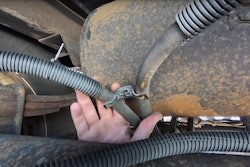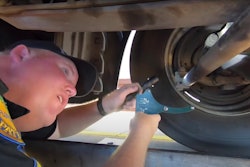Trucking news and briefs for Friday, June 23, 2023:
Automatic emergency braking mandate proposal looming
The U.S. Department of Transportation is moving forward with a proposed rulemaking to mandate automatic emergency braking (AEB) systems on trucks with a gross vehicle weight rating of more than 10,000 pounds.
The National Highway Traffic Safety Administration (NHTSA) and Federal Motor Carrier Safety Administration (FMCSA) announced Thursday a notice of proposed rulemaking (NPRM) that will be published soon would require AEBs on heavy trucks “that will mitigate the frequency and severity of rear-end crashes.”
The agencies noted that they “have jointly determined not to propose retrofitting requirements” for trucks already in service.
An AEB system uses multiple sensor technologies that work together to detect a vehicle in a crash-imminent situation. The system automatically applies the brakes if the driver has not done so, or, if needed, applies more braking force to supplement the driver’s braking. The proposed standard would require the technology to work at speeds ranging between low-speed (6 mph) and high-speed (roughly 50 mph) situations.
“Establishing AEB standards is a key component of the Department’s National Roadway Safety Strategy,” said FMCSA Administrator Robin Hutcheson. “This technology can enhance the effectiveness of commercial motor vehicle crash reduction strategies and reduce roadway fatalities.”
The notice will also include a proposal to require nearly all heavy vehicles to have an electronic stability control system that meets the equipment requirements, general system operational capability requirements, and malfunction detection requirements of FMVSS No. 136.
“Considering the effectiveness of AEB and electronic stability control technology (ESC) at avoiding these crashes, the proposed rule would conservatively prevent an estimated 19,118 crashes, save 155 lives, and reduce 8,814 non-fatal injuries annually once all vehicles covered in this rule are equipped with AEB and ESC,” the rule states. “In addition, it would eliminate 24,828 property-damage-only crashes annually.”
NHTSA earlier this month opened an investigation into reports of “false positive” activations of AEBs on Freightliner Cascadia and Western Star 5700 trucks. In the NPRM, the agencies address this by requiring that vehicles pass two test scenarios without false activation of the system.
The American Trucking Associations welcomed the announcement of the NPRM, noting that it “has long supported the use of AEB on all new vehicles,” according to ATA Vice President of Safety Policy Dan Horvath. “With NHTSA’s recent regulation requiring AEB on all new passenger vehicles, this proposal for heavy-duty trucks is timely and appropriate.”
Similarly, the Truck Safety Coalition lauded the proposal’s announcement. “I’m grateful that countless families will never experience the depth of pain and suffering that accompanies losing a loved one in a horrific truck crash,” said Tami Friedrich, Truck Safety Coalition Board President. “This has been a long time coming and will provide everyone enhanced protections they deserve from the dangers of large trucks.”
NHTSA and FMCSA will accept comments on the proposal for 60 days once it is published in the coming days.
[Related: NHTSA investigating 'false positive' automatic emergency braking activations]
Loadsmith equipping 800 trucks with Kodiak Driver for new freight network
Autonomous trucking firm Kodiak Robotics announced that digital load board Loadsmith will equip 800 trucks with Kodiak’s self-driving technology, the Kodiak Driver.
The Kodiak-equipped autonomous trucks will serve as the foundation for the newly established Loadsmith Freight Network (LFN), the first-ever freight transportation company built specifically for self-driving trucks, the companies said.
Kodiak will begin delivering the Kodiak Driver-powered self-driving trucks in the second half of 2025.
The Kodiak trucks on the LFN will transport goods autonomously on the interstate portions of highway routes. Loadsmith’s fleet of trucks equipped with the Kodiak Driver will complete the long-haul portions of Loadsmith’s deliveries, while human-driven trucks, booked on Loadsmith’s platform, will do local pickups and deliveries.
By pairing autonomous long-haul trucks with local drivers that will rendezvous at hubs along and within the LFN, Loadsmith and Kodiak will enable shippers to move freight more efficiently, reliably, and safely.
“Loadsmith is the first trucking company built specifically for autonomous trucks, and we are proud that they selected Kodiak as the backbone of their operations,” said Don Burnette, Founder and CEO of Kodiak Robotics. “Loadsmith’s Founder Brett Suma is one of trucking’s true visionaries, and now he is using his deep and unique experience to rethink logistics for the autonomous era.”
Loadsmith’s platform will strategically deploy 6,000 trailers on the LFN to maximize the utilization of the Kodiak-powered trucks on the network. By pairing self-driving trucks and local manual trucks on the same network, Loadsmith can rapidly scale autonomous deliveries and convert significant amounts of freight volume from traditional trucking methods to a more flexible and on-demand service, the companies said.
Volvo, University of Minnesota testing electric trucks in extreme climates
Volvo Trucks North America is working with the University of Minnesota (UMN) to conduct extreme weather testing for its Class 8 VNR Electric model to analyze the impact of ambient temperature on a truck’s battery life.
UMN has teamed up with Murphy Logistics Solutions to test the battery-electric trucks in Minnesota with cold winter temperatures and H-E-B Grocery Company (HEB) in Texas to test during periods of intense summer heat.
The extreme weather testing project, which will demonstrate the capability of the Volvo VNR Electric using real-world fleet routes, is part of a Battery Efficiency for Sustainable Trucks (BEST) Project sponsored by the U.S. Department of Energy’s (DOE) Vehicle Technology Office.
The project will track the results of two Volvo VNR Electric engineering trucks with a six-battery configuration that are rated to provide up to 275 miles of range. Volvo Trucks is analyzing the battery-electric trucks’ performance on different routes in extreme temperatures with varying terrains and payload weights to better understand the challenges these factors present to help customers improve route planning and optimization.
Murphy and HEB will operate the battery-electric trucks on freight routes that exceed 250 miles in a day utilizing drivers in their fleets who have been trained by the Volvo Trucks electromobility team to utilize regenerative braking and other safe driving practices designed to maximize vehicle range. The VNR Electric trucks will leave the warehouse at the beginning of the day with a 100% state of charge (SOC) and will ideally return near empty (about 10% SOC) at the end of their routes to take full advantage of useable energy in the battery.
Volvo said heavy-duty battery-electric trucks can experience range reductions during extreme temperatures due to battery chemistry where the chemical and physical reactions in the battery can occur more slowly, reducing the BEV’s range. To combat that, a dedicated Battery Thermal Management System (BTMS) is included with the Volvo VNR Electric model to manage and maintain the optimum battery temperature range.
The other significant factor is the use of auxiliary power to either cool or warm the passenger cabin. If the ambient temperature is significantly above or below 70-71 degrees Fahrenheit, the driver is more likely to turn on the heat or air conditioning, which draws energy from the battery.











